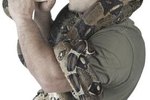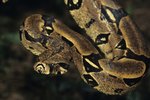
Red-tailed boa constrictors originate from tropical South and Central America, from Brazil and Columbia all the way north through Mexico. These strong, cold-blooded reptiles are nonpoisonous, popular pets, but don’t take them lightly. Red-tailed boas are a huge, long-term commitment, and they can live for more than 30 years in captivity.
Physical Features
Newborn red-tailed boa constrictors are 14 to 22 inches long and weigh a measly 2 ounces. However, within its first year, that baby who fits in the palm of your hand will grow up to 8 feet long. A fully grown adult red-tailed boa can easily reach 10 feet in length and 50 pounds in weight. His brown and gray scales are adorned with brownish black oval patches that become increasingly red towards the base of his tail.
Behavior
Red-tailed boas generally are docile snakes, though wild-caught boas tend to be more aggressive than captive-bred boas. In the wild, they’re solitary reptiles, preferring to spend their days in hollow logs and abandoned mammal burrows or, being partially arboreal snakes, hanging on low branches. They generally only spend time together during mating, which can take place at any point throughout the year.
Habitat
Wild red-tailed boas prefer woodlands, semi-arid forests and tropical rain forests. Though they love warm, humid weather, boas are nocturnal and spend the hot days lazing about under logs or cooling off in rivers, and the cooler nights hunting prey. Captive boas don’t have the luxury of the Amazon rain forest and need an enclosure with a daytime air temperature between 82 and 90 degrees, with a separate “basking” area kept between 90 and 95 degrees. At night the temperature should go no lower than 78 degrees. Clean, sturdy branches for climbing, a suitable hiding place -- hollow logs work well – and fresh water can ensure your pet red-tailed boa remains happy and healthy.
Diet
Red-tailed boa constrictors are carnivores. Their natural prey includes rats, mice, amphibians, snakes, birds, eggs and small mammals. In captivity, most boas eat mice, rats, rabbits and even chickens. Red-tailed boas aren't constant eaters; in some cases a large meal can sustain a boa for up to a month. A boa kills its prey by squeezing it to death with its powerful coils. Once its prey has suffocated, the boa constrictor consumes it whole.
References
Resources
Photo Credits
-
Tom Brakefield/Stockbyte/Getty Images
Writer Bio
Christina Stephens is a writer from Portland, Ore. whose main areas of focus are pets and animals, travel and literature. A veterinary assistant, she taught English in South Korea and holds a BA in English with cum laude honors from Portland State University.




